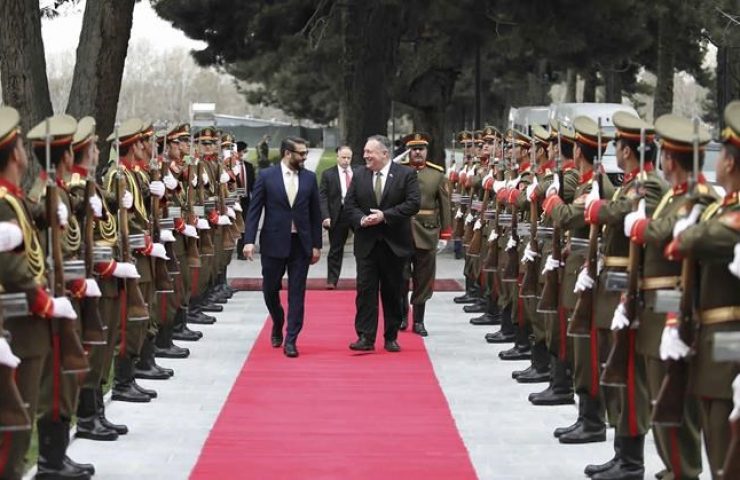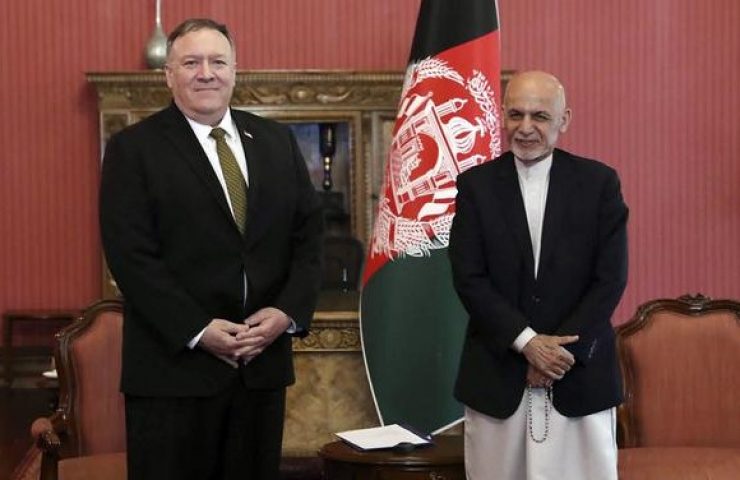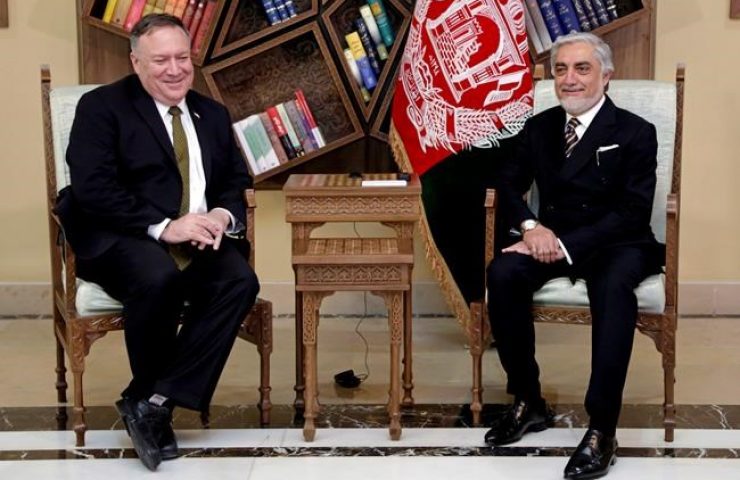A lack of prior liaison on the eventual form of government in Afghanistan leaves vague prospects for a consensual peace.
Follow us on LinkedIn
U.S. Special Representative for Reconciliation in Afghanistan Zalmay Khalilzad had a regional tour from June 29 to July 4, 2020, visiting Islamabad, Doha and Tashkent, to expedite the commencement of peace talks and discuss the best way forward.
The long-awaited start of intra-Afghan negotiations is an encouraging signal not only for Afghanistan but for the entire region, too. The peace would yield significant geopolitical and geo-economic benefits and could become a central component in overcoming the current. COVID-19 pandemic – induced economic crisis in the region.
In that regard, it would seem pertinent to analyze the power structures ahead of conceivable negotiations, prerequisites for potential trade-offs, and assess the prospects for an agreement that would meet the needs of both Afghanistan and its neighbors.
Afghan government: fragile sponsorship consensus
Over the past year, a legitimate government of Afghanistan has been sorely tested. The presidential election, once more, ended in fragmentation, and amidst the US-Taliban talks both presidential candidates, ethnic Pashtun Ashraf Ghani and the Tajik population representative Abdullah Abdullah, solemnly proclaimed themselves head of state, a case without precedent in modern times.
Predictably, the conflict ended with the signing of an agreement[1], according to which Ghani was re-elected as the president, whilst his opponent had to settle for the less. Endorsing the results, Abdullah was appointed the Chief Executive, now he has the right to appoint half of the government and an honor, albeit dubious under the prevailing circumstances, to be heading peace talks with the Taliban as head of the Supreme National Reconciliation Council.

The predictability of the agreement between Ghani and Abdullah is attributable to the historical realities of Afghanistan. With whatever government in power – from the monarchy to the emirate and from communists to democrats – Pashtuns were the majority in rule, while ethnic minorities led by Tajiks, constituting about quarters of the country’s population, fully tried to benefit from these agreements. Instructive in this regard is the fact that the leader of Afghanistan’s Uzbeks, Abdul-Rashid Dostum, having attained the position of the First Vice-President in past elections, was content with being promoted to marshal rank and the membership in the National Security Council and the High Council.
The agreement put an end to a months-long stalemate that plunged the country into a political crisis and allowed Kabul authorities to act as a single party to a potential peace process. At the same time, the Islamic Republic of Afghanistan remains a relatively decentralized state in which the nominally strong presidential power and the presidential election’s basic principle, i.e. “the winner takes it all”, is enfeebled by the reinforced regionalization. Particularly, the power-sharing deal ensures provincial governors get appointed by both sides[2], although the previous agreements suggest a poor reinforcement.
As in past elections, U.S. intervention was essential in securing the deal. Washington has been trying to reach a substantive outcome on the Afghan situation for a long time. The February agreement with the Taliban has, to some extent, formalized the withdrawal of troops, making it appear to progress in peace talks. The United States-backed Afghan government maintains unity only with U.S. direct intervention.
The fact that the power-sharing deal between Ghani and Abdullah has been once again mediated by the United States indicates the persistent nature of an extremely fragmented political environment with strong local actors that exercise control or influence on the military and police forces. Since the formal State institutions do not provide for the constitutionalized power-sharing that reflects national realities, Kabul mightily depends on Washington as an outside mediator for extra-constitutional negotiations.
The Afghan security forces have yet to experience serious dissension – even during two inaugurations in March 2020, security forces in Kabul were mobilized for security arrangements at both ceremonies,[3] but political differences in the face of strategic uncertainty could be a significant obstacle for their cohesion. Besides, the coherence and combat readiness of the security forces directly depends on funding.
Apart from the power struggle, the Afghan government is encountering the increasing socio-economic challenges, including unemployment and deteriorating security environment. For example, the annual expenditures of the Afghan government are $ 11 billion, whilst its revenues barely reach $ 2.5 billion. The deficit should be covered by external assistance[4]. In 2020, severe losses from the COVID-19 pandemic, which might translate economic collapse into reality, will be added to the plight of Afghanistan.
What does Kabul have to offer?
Amidst an ongoing internal political unrest and tenuous consensus, the peace terms and potential concessions Kabul ready to make are obscure even for Washington[5]. At the same time, Donald Trump needs some successes right now, at the presidential election year; hence, the incumbent White House administration’s attempts at bringing the parties together and only give the impression of progress, trying to save face where it’s running short in leverages.
United States Secretary of State Mike Pompeo arrived with an urgent mission to Kabul on March 23, 2020 to try to advance the US peace agreement previously signed with the Taliban. Pompeo’s trip to the Afghan capital takes place in spite of the coronavirus pandemic, while world leaders and statesmen are cutting back on official trips. Photo: Afghan Presidential PalaceIn an interview for the Atlantic Council in June 2020, President Ghani had been unable to formulate even crude peace terms, except for the generalities about the republic and human rights. Afghan President considers the resignation from the presidency for a peaceful future to be a mistake that Najibullah once made and which he does not intend to repeat[6].
However, the greatest similarity between Ghani and Najibullah lies in total dependence on external assistance. The pro-Soviet regime of Najibullah did not collapse in 1989 when Soviet troops were withdrawn from Afghanistan, but less than two months after the Russian Federation stopped aiding his government on January 1, 1992. The current political system of the IRA and its security forces subsist on foreign funds. So long as Afghanistan continues to receive external assistance, President Ghani can deal with it, while delegating the peace talks to Abdullah Abdullah.
The resignation of the president and the formation of an interim government could be vital for a peaceful settlement. This would, however, be only possible under external pressure or the threat of the interior collapse, as Ghani’s denial implies the simple non-acceptance of the mere fact that someone else will manage resource flows in the country.
Preserving the current constitutional norms appears impractical in peace negotiations, as a political system cannot settle disputes without the Taliban, let alone when the latter are involved
Triumphant: The Taliban
As a centralized force, the Taliban has always been considered relatively weak. Its leadership, nonetheless, sought to maintain the political and ideological unity of the organization. The semi-legendary Mullah Omar was an icon of the movement, but his successor, Mullah Akhtar Mansur, did not enjoy the same authority and contributed to further fragmentation of the movement.
Since 2016, under the leadership of Haibatullah Akhundzada, the Taliban has suggestively strengthened internal unity and built a relatively stable governance system. The head of the Taliban movement is primarily responsible for political and religious affairs, while his deputy, Sirajuddin Haqqani, is in charge of military operations. The Haqqani network that he leads is different from traditional tribal structures and has a different organizational history. His network is increasingly influential and is gradually expanding not only outside Afghanistan but also in South Asia[7].

Although there are an effective hierarchy and vertical subordination, local “autonomy” remains a significant challenge. First, this is necessitated by popular support. Field commanders are often more attuned to the immediate military situation and view localized success as being more important.
Under Akhundzada’s leadership, the Taliban had scored significant military successes, and the movement is considered more united and less susceptible to fragmentation than before. It is estimated that there are currently 60,000 Taliban full-time fighters. The Taliban retain the ability to launch large-scale attacks, including in towns, while also demonstrating substantial tactical opportunities. Today they control more territory than ever since 2001, and it has become increasingly evident that they will be decisive in any format of a future political settlement[8].
By 2018, swaths of rural Afghanistan were effectively under Taliban control. This control came about not only as a result of a huge military exercise but also in response to the campaign of “creeping influence”, facilitated by the movement’s growing civilian capacity[9].
The Taliban make and approve policies based on three core factors: security (military dimension), political ramifications, and religious suitability. Any decision would be examined by commanders based on its security and political ramifications but would also require the endorsement of religious scholars. Shadow governors are heavily involved in both civilian and military affairs. In practice, a shadow governor has the power to adapt, ignore, reject, or argue against the implementation of Taliban leadership requirements in “their” provinces[10].
The February agreement with the United States was seen by the Taliban as a long-awaited victory in a long-standing conflict. The agreement between the United States and the Taliban has been triumphant for neighboring Pakistan. The Taliban’s closest ally, Islamabad, whose ties over many years of war have served to aggravate relations with Kabul and Washington, had offered to bring the Taliban to the negotiating table, and later to a deal. In this regard, the pertinent question is how relevant a peaceful settlement with those whom the Taliban calls American “puppets”, as well as what are the Islamabad’s interests in this matter.
Do the Taliban need an agreement with Kabul?
Following the February agreement, which provided the Taliban with everything they insisted on – direct agreements with the United States and not with their “puppets” and the complete withdrawal of foreign troops as the dominant discussion topic – their position on peace talks seems ambiguous.
On the one hand, the Taliban think they “won” the war, wherein the corresponding agreement was signed with Washington, and not with Kabul. According to its terms, the Taliban will instigate intra-Afghan negotiations with the parties to the conflict, without recognizing the legitimacy of the Afghan government and its obligations regarding the negotiation agenda or their results, unless it’s the release of prisoners and a comprehensive ceasefire discussion.
The Taliban will almost certainly reject the peace terms that would leave a significant number of insurgents disappointed or demoralized, while also depriving them of their identity as an armed organic entity and/or hampering their efforts to ensure unity in their ranks. Significant concessions can cause a split among the Taliban, and the unity of the Taliban movement is necessary to ensure compliance with the agreements. Any peaceful resolution to the Afghan conflict heavily relies on the integrity of the movement.
President Ghani is still a “puppet” for the Taliban and talks with him or Abdullah could focus on their resignation and the surrender of Kabul.
The “winners” are unlikely to make a power-sharing deal with those whom they portray as “puppets”. Besides, given the Ghani’s current position, is it difficult to imagine that the Taliban would defer to him or Abdullah, or become part of the current “puppet” government? It is unlikely that the Taliban are willing to give up orthodox religious demands, which are an integral part of their political culture. In other words, there is very little room for maneuver in negotiations.
The Taliban, on the other hand, needs international recognition. This factor is sort of a key to achieving political ends. This is reflected in the Taliban’s rhetoric – for example, an interview Haqqani gave to the New York Times[11], and the policies that contributed to successful negotiations with the US. The growing openness of the Taliban leadership and interaction with international actors was one of the indicators of the quest for credibility. The Taliban’s willingness to complete the exchange of prisoners in accordance with the February agreement and the newly reaffirmed consent to commence peace talks in June 2020 given to the US Special Representative Khalilzad in Doha[12] are more recent examples of Taliban’s efforts to seek international recognition.
From a military perspective, the Taliban will hardly be able to seize Afghan power on its own; without a deep-seated change in the balance of forces. It could be possible, for instance, with the diminishing international support for the Kabul authorities and, consequently, the fragmentation and collapse of its army. The Taliban stands as a powerful military-political force, without which a peaceful settlement is not possible. This movement, though, is not strong enough to overthrow the Ghani’s government in the current alignment of forces.
The intricacy of the Taliban’s takeover of Afghanistan is recognized in Pakistan, too. Such attempts will facilitate the further involvement of regional opponents, primarily India and, most likely, Russia. It is for this reason that Pakistan, than any other scenario, would prefer the status quo and certain chaos, with the Taliban retaining its main military force and salvaging its influence on the situation in the country.
In general, the intra-Afghan negotiations suffer from considerable strategic uncertainty. The incomplete exchange of prisoners and the continued hostilities compare favorably with the weak and fragmented government in Kabul; the diminishing influence of the United States; the Taliban who feel victorious and their allies from Pakistan; and ambiguous stands on potential trade-offs. Meanwhile, the compromises that the parties to the conflict, above all the Taliban, could tolerate, – in the name of peace and international recognition – remain key agenda items in the peace process.
In that context, the commencement of peace talks may signify not so much an inclination to peace agreement as an attempt at some tactical purposes. The White House prove their fineness in the peace process at a critical time for the election campaign. Kabul will reiterate its importance as an equal partner. The Taliban can rest assure on some strengthening of its international profile, wherein Pakistan perceptibly hopes for further erosion of Kabul authorities and India’s position in Afghanistan, hindering the so-called “strategic environment”.
A lack of prior liaison on the eventual form of government in Afghanistan leaves vague prospects for a consensual peace. If there is a rationale behind the feasibility of commencing negotiations, then the hopes for the peace process outcome expressed by Special Representative Khalilzad during his regional tour look overly optimistic.
This material has been prepared as part of the Giving Voice, Driving Change – from the Borderland to the Steppes Project. The opinions expressed in the article do not reflect the position of the editorial board or donor.
[1] Political Agreement. Unofficial Translation. https://tolonews.com/pdf/ab_agr_tn.pdf
[2] Ibid
[3] Shereena Qazi. Will the Ghani-Abdullah rivalry undermine Afghan peace process. 9 Mar 2020. – https://www.aljazeera.com/news/2020/02/ghani-abdullah-rivalry-undermine-afghan-peace-process-200221052054522.html
[4] Max Boot, The Riskiness of the U.S. Deal to Leave Afghanistan. Council for Foreign Relations, March 2, 2020. https://www.cfr.org/in-brief/riskiness-us-deal-leave-afghanistan
[5] Clayton Thomas. Afghanistan: Background and U.S. Policy: In Brief. Congressional Research Service. June 25, 2020. https://fas.org/sgp/crs/row/R45122.pdf
[6] Transcript: Afghanistan’s vision for peace: A conversation with H.E. President Mohammad Ashraf Ghani. Atlantic Council. June 11, 2020. https://www.atlanticcouncil.org/uncategorized/transcript-afghanistans-vision-for-peace-a-conversation-with-h-e-president-mohammad-ashraf-ghani/
[7] Melissa Skorka. Afghanistan Endgame, Part One: Is Sirajuddin Haqqani Ready for Peace? Council for Foreign Relations, August 14, 2019. – https://www.cfr.org/blog/afghanistan-endgame-part-one-sirajuddin-haqqani-ready-peace
[8] Clayton Thomas. Afghanistan: Background and U.S. Policy: In Brief. Congressional Research Service. June 25, 2020. https://fas.org/sgp/crs/row/R45122.pdf
[9] Ashley Jackson and Rahmatullah Amiri. Insurgent Bureaucracy: How the Taliban Makes Policy. United States Institute of Peace. November, 2019. – http://www.acbar.org/upload/157666190089.pdf
[10] Ibid
[11] Sirajuddin Haqqani. What We, the Taliban, Want – The New York Times. February 20. 2020. https://www.nytimes.com/2020/02/20/opinion/taliban-afghanistan-war-haqqani.html
[12] Khalilzad Discusses Development Plans With Qataris, Taliban. TOLOnews. 04 July, 2020. https://tolonews.com/afghanistan/khalilzad-discusses-development-plans-qataris-taliban




